I Asked Architects for Their Tips to Make a Kitchen Extension More Cost-Efficient — Without Feeling Like You're Cutting Corners
These were their best design hacks to create a wow-factor space, without breaking the bank
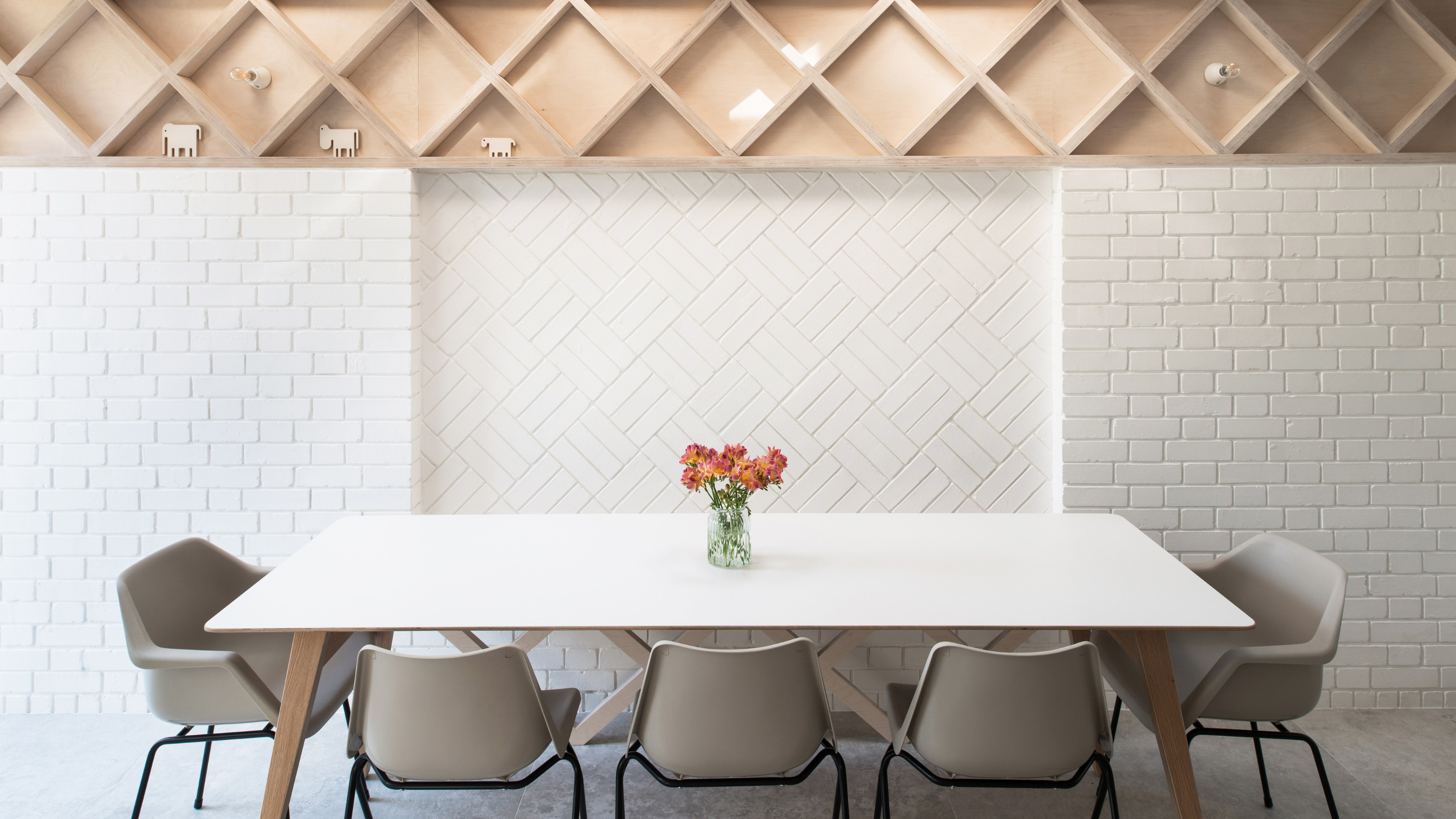

In most homes, the kitchen is the heart of the action — it’s the place where you spend time with family, prepare meals, do homework with the kids and entertain guests. But with so many extension designs at your fingertips, it can be challenging to craft a brief that meets your needs — without allowing costs to spiral.
Adding a kitchen extension to your home doesn’t have to cost a fortune. The design that offers the best value (single-story, double-story, or side-return) will depend largely on the size, style, and layout of your current property. Start by asking yourself what your existing kitchen currently fails to deliver. From there, you can start crafting a brief that prioritizes your budget into ‘must-have’ elements versus ‘nice to have’ details.
If you are working with a fixed amount, know that you might have to make design compromises — but that doesn’t mean you can’t create a kitchen extension that’s stylish, functional, and meets the unique points on your brief. Here, we spoke to the experts to discover their best hacks for creating maximum design impact without cutting corners or breaking the bank.
1. Incorporate Interesting Materials
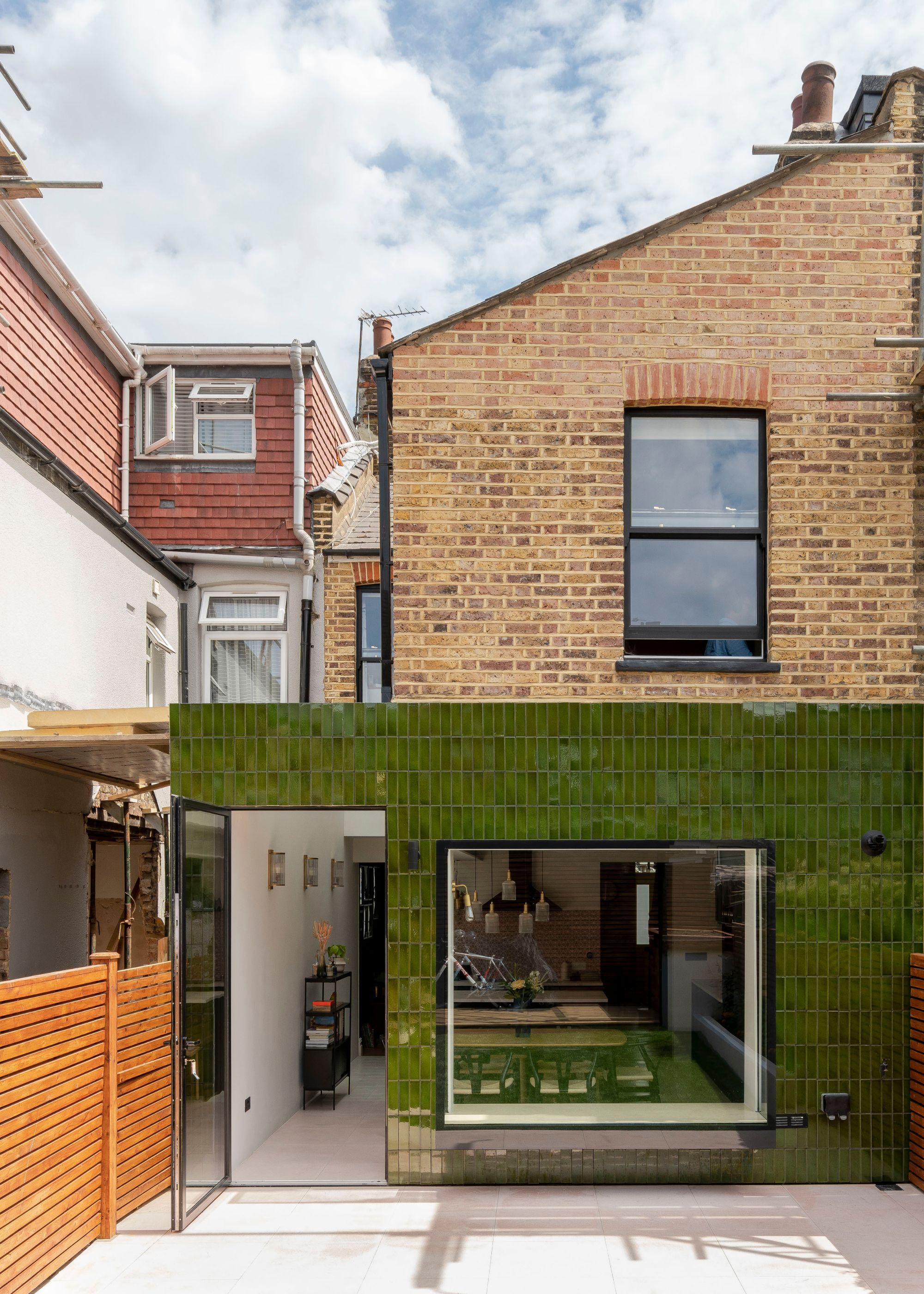
Mix and match materials for a bold finish.
Introducing colorful or unusual exterior cladding materials can provide a striking design detail to make your kitchen extension stand out. According to architect James Dale, this strategy can be surprisingly cost-effective, too.
"On our Brooke Road project, we created a contemporary look to the kitchen extension by wrapping it with high gloss, green tiles to create a wonderful finish without breaking the budget," he says.
A solution such as gloss kitchen tiles injects a burst of color that contrasts with traditional brickwork and works extremely well on extensions to Victorian or post-war properties. This cladding solution comes with many practical benefits, too – it’s durable, requires minimal maintenance, and lasts 150+ years, plus it may not be as expensive a choice as some external cladding but looks just as luxurious.
James Dale is the director of James Dale Architects, an established design practice based in north London, specialising in creating innovative, residential renovation and extensions for projects across London and the southeast. All projects are design led with a contemporary approach internally and externally, resulting in reimagined modern dwellings.
2. Elevate a Budget Kitchen With Paint
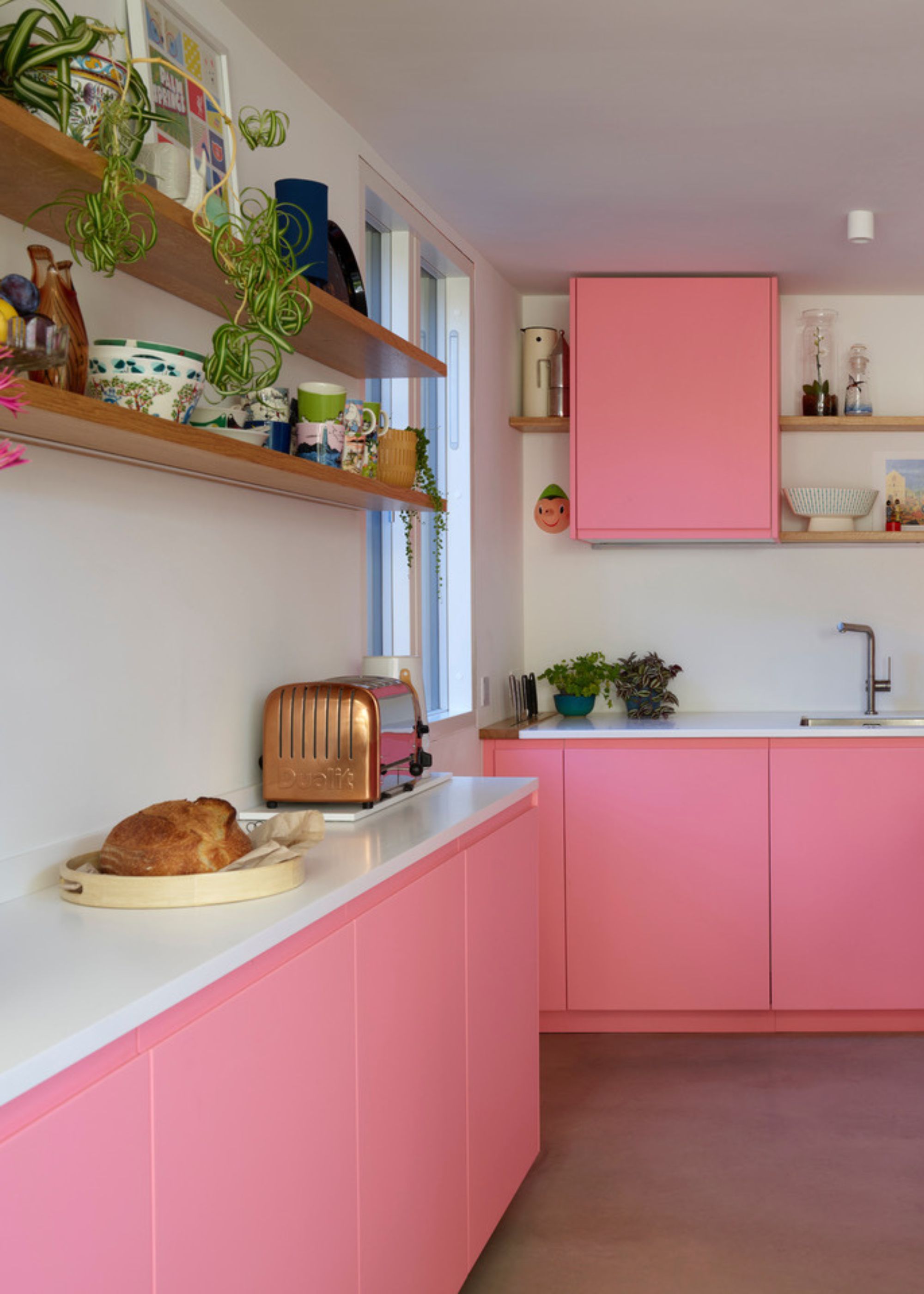
A splash of pink can be quite a showstopper.
"Don’t be afraid to deviate from the stock colors and materials available from high street suppliers," says Robert Sterry from Paul Archer Design, and he suggests that injecting a burst of bright color into your kitchen can play a major role in creating a bespoke, design-led feel, it also makes for the perfect kitchen color idea.
"A strong color scheme will have a big impact without the cost of fully bespoke cabinetry," says Robert. In this kitchen, IKEA kitchen cabinets have been re-sprayed in a bright shade of pink to add an element of personalization and playfulness to the space.

Price: £5.50 per sample
Fancy a bright pink for your kitchen? We love this shade from Little Greene which balances vibrancy and sophistication.
Robert Sterry is a director at Paul Archer Design. Robert graduated from the Welsh School of Architecture. He worked at heritage specialists Niall Phillips Architects, now Purcell, on several museum and cultural projects. Robert leads technical standards and is enthusiastic about adapting and upgrading existing buildings to meet modern environmental needs, with a particular interest in promoting a sympathetic approach to our historic projects
3. Pick Picture Windows Over Full Glazing
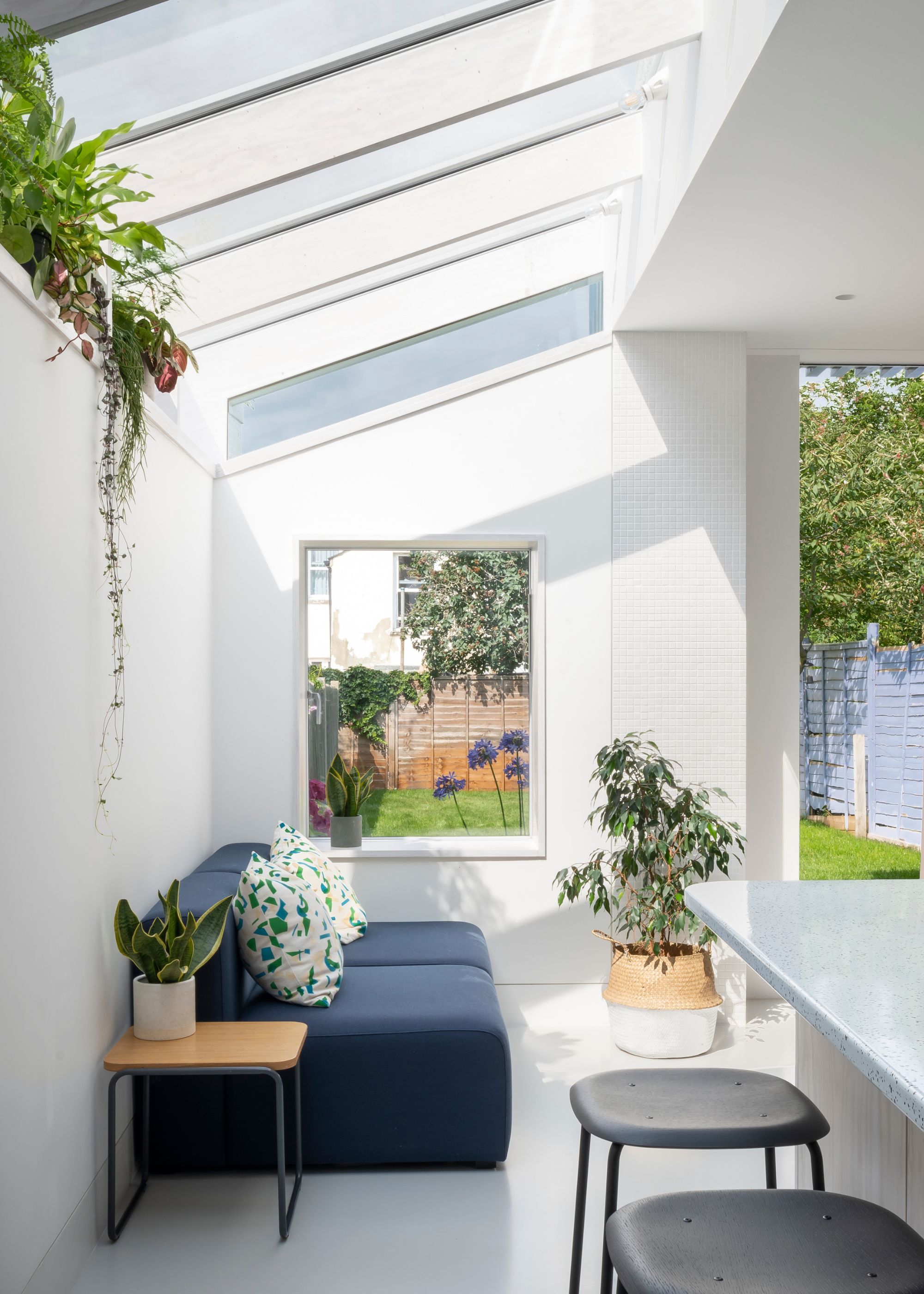
A portable to the outside world perhaps?
Bringing in plenty of natural light is usually at the top of the priority list for most homeowners who are in the process of designing a kitchen extension. However, broad expanses of glass typically represent one of the most sought-after design details that can eat up your budget.
"To keep costs down and maximise daylight go for a large picture window rather than bifold doors," says Robert from Paul Archer Design. "Large, simple glazed elements can give a stronger visual connection to exterior spaces, giving smaller extensions a greater sense of space."
Designed by CAN Studio, this rear side extension to a Victorian terraced house features a picture window paired with a glass door and overhead glazing. The deep kitchen window beautifully frames the garden view and helps draw the eye through the space and beyond.
4. Specify Off-the-Shelf Glazing
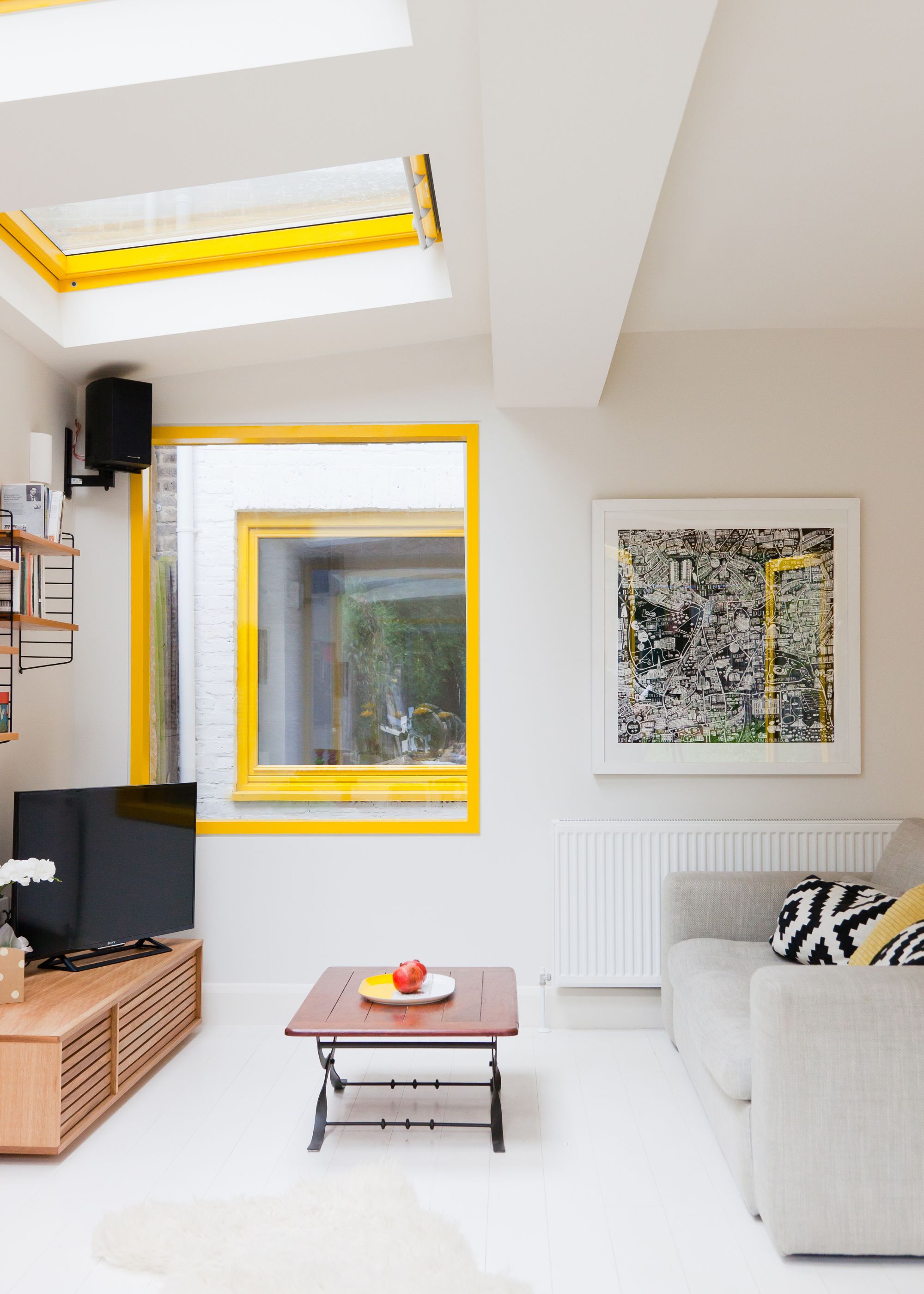
Save money with off the shelf, rather than bespoke.
Buying off-the-shelf products rather than going bespoke is a smart way to conserve cash. From the outset, designing your extension to incorporate standard window and door widths can make a big difference, as made-to-measure solutions — particularly when it comes to glazing — are likely to drive your build costs up substantially.
"High-quality glazed units can be one of the more expensive elements within a build, but they’re totally worth it,” says James Dale. “By selecting standard, off-the-shelf glazed units, it can dramatically reduce the cost but still offer a stunning finish."
In this project by Nimtim Architects, standard size rooflights from Velux were installed to bring in plenty of sunshine, without splashing a big chunk of the budget on bespoke overhead glazing.
5. Install IKEA Carcasses With Bespoke Cabinet Fronts and Worktops
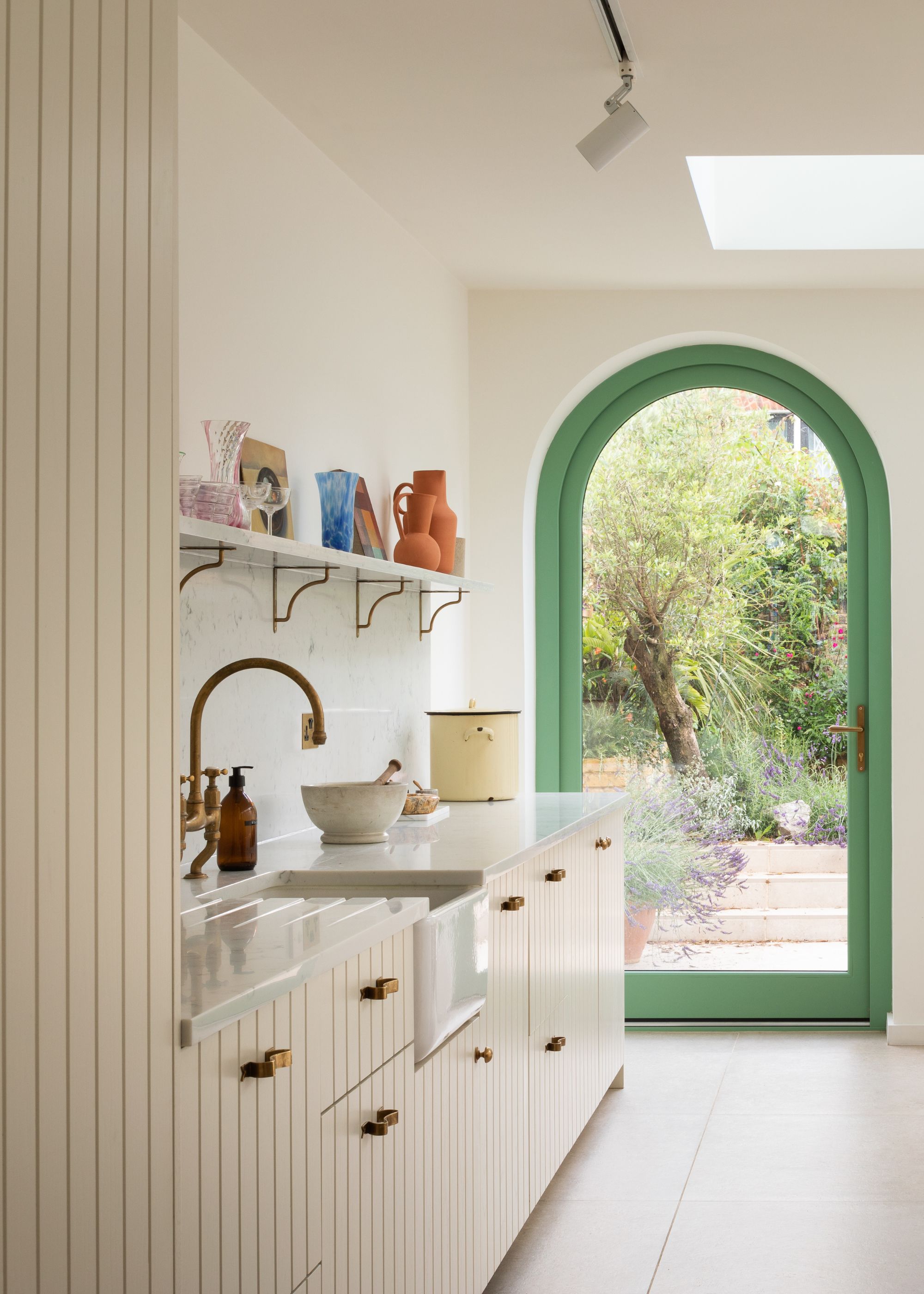
IKEA offers affordable and stylish kitchen carcasses.
If your goal is to minimize spending, it’s important to get savvy when it comes to kitting out your kitchen. When your budget is tight but you have big design ambitions, invest in the finishes that are visible. It'll make a big difference in how much your kitchen costs.
Many companies specialize in crafting bespoke cupboard fronts for standard IKEA kitchen carcasses. This kitchen extension by Turner Architects employed this strategy to maximum effect – IKEA carcasses are paired with cabinet fronts, handles, and worktops from an alternative supplier to create a more personalized, design-led feel.
"You can build up quite a bespoke look using everyday suppliers, not at the cost of other bespoke kitchens," says Paul Turner of Turner Architects. "Nice ideas don’t have to cost a fortune – keeping things simple can be quite powerful in terms of vision. Think about the narrative and try to pitch what you’re proposing against the story you’re trying to tell, and make it personal to the house."
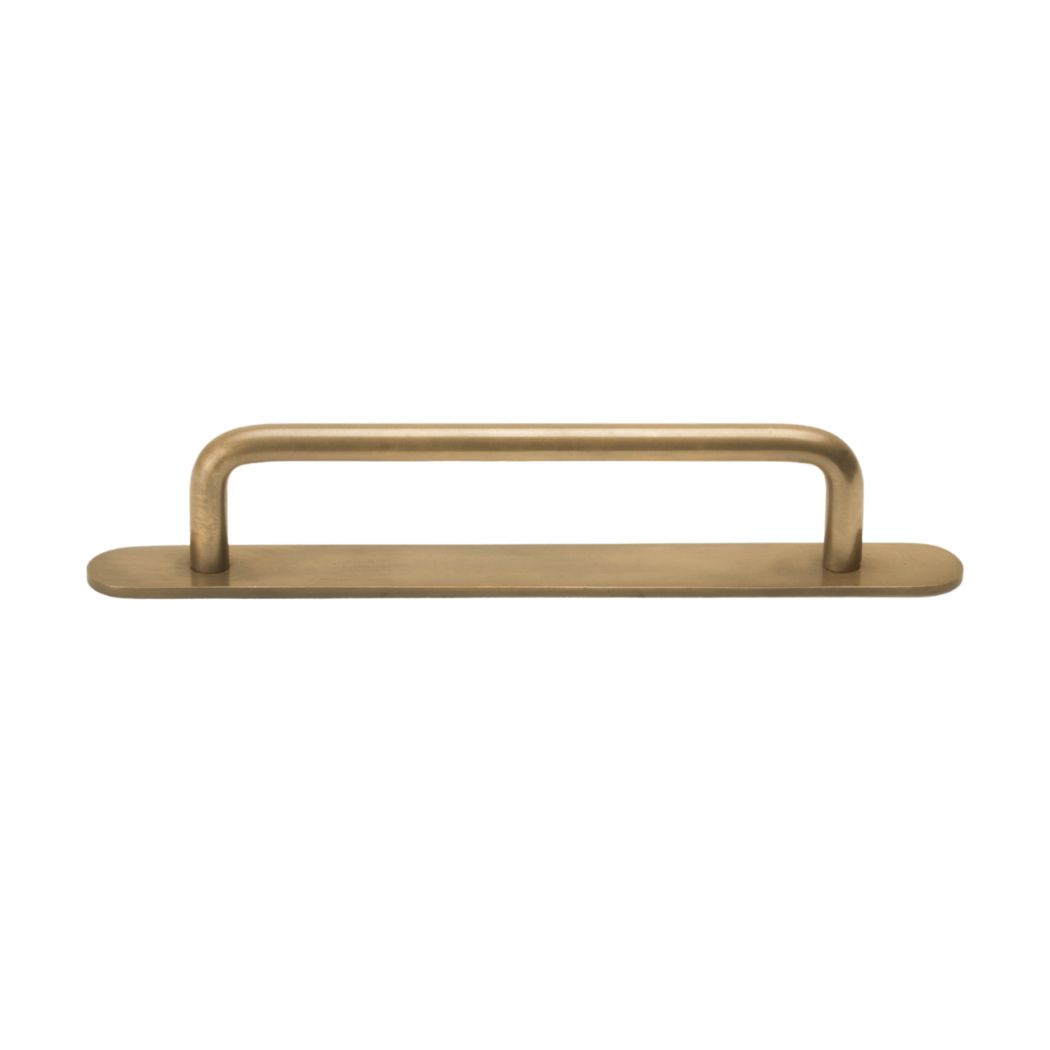
Price: £17.70
If you are going to invest in something for your cabinetry, good handles can really elevate the look.
Paul Turner is the director of Turner Architects. He studied at the Mackintosh School of Architecture at the Glasgow School of Art, Cass School of Art and University of Cambridge. He has worked for a number of RIBA award winning practices before setting up Turner Architects in 2014
6. Use Simple Materials to Create Pattern
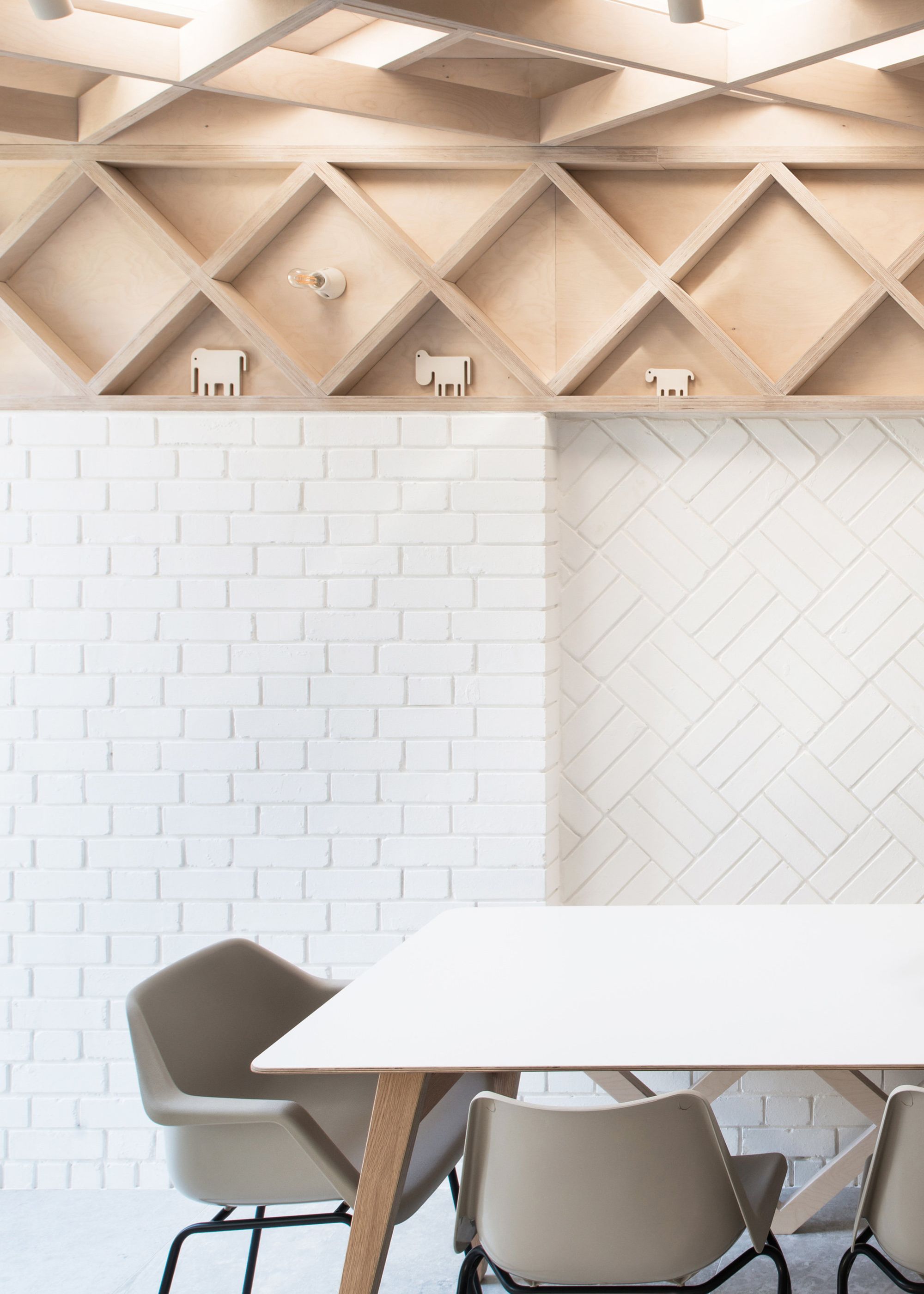
Mix your brick and tile layouts to create a seamless feel throughout your space.
Sticking to a simple materials palette can help you save on overall costs — but it doesn’t mean you have to compromise on wow factor, as this kitchen extension by Forgeworks demonstrates.
Forgeworks designed this infill extension to a traditional period property. Though it only adds around 8 square meters of space, the extension has transformed the ground floor – and the use of pattern is one of the standout design details and adds pizzazz to the rustic kitchen.
"We didn’t want to cover up the brick wall – you can get so much character out of the original building technique, which is Flemish bond brickwork," says Chris Hawkins from Forgeworks. "We painted the wall white to keep it nice and simple and then introduced basket weave brickwork to mimic the timber lattice above."
7. Use Built-in Joinery in the Right Places
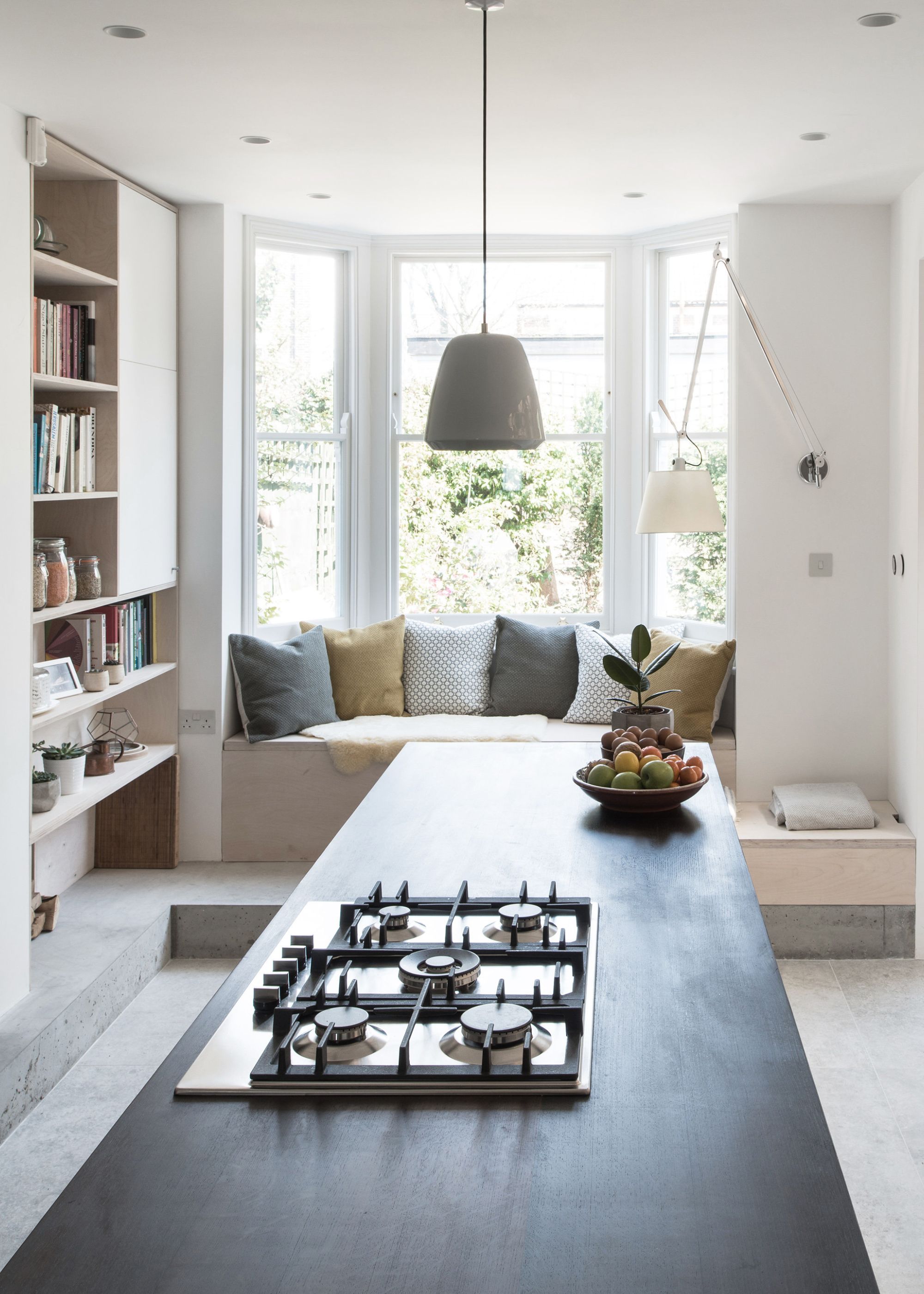
Who doesn't love to look out at nature?
Beautiful joinery that’s designed to fit the dimensions of your kitchen is practical, as it’ll help you maximize every nook and cranny. Plus, it brings a tailored design detail to the space. If you don’t have the budget to kit out your entire kitchen with bespoke fixtures and fittings, picking one or two elements — such as a window seat — can help create a bespoke feel.
"A window seat makes the most of the view, allowing you to enjoy the garden all year round," says Rob from Paul Archer Design. "In a smaller extension, this can create a simple, flexible space that can either be used separately from the kitchen and dining area or as an extension of either."
In this infill extension project by Forgeworks, the owner wanted to preserve the bay window at the back of the property rather than knocking it out and installing a run of glazed doors across the width of the house. Incorporating a window seat highlights this characterful, original feature and provides the perfect spot to enjoy a morning cup of coffee.
8. Keep Things Straight
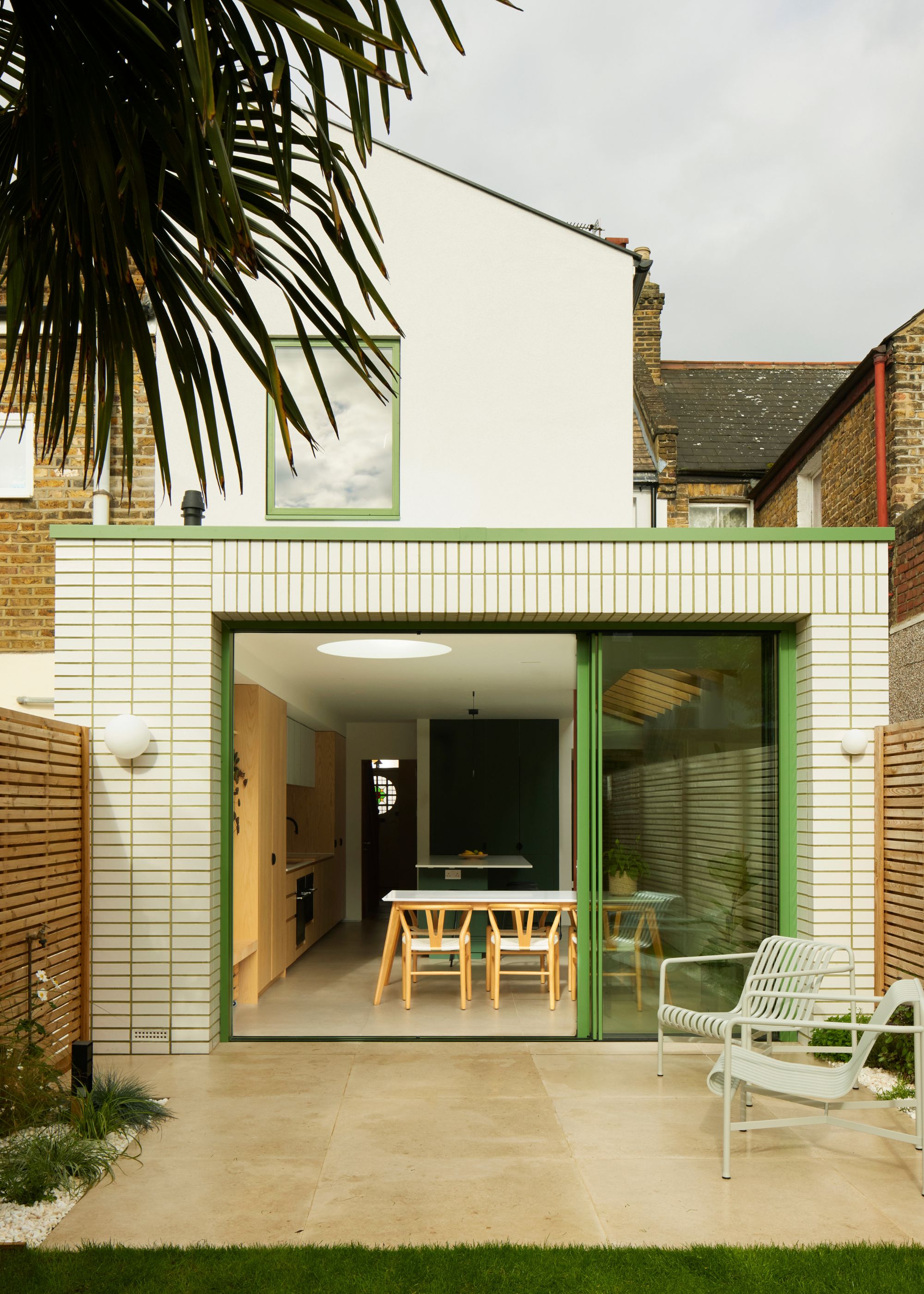
You can never go wrong with a simple design.
Creating a kitchen extension that’s a straightforward shape will be cheaper to execute. The moment you introduce curved walls, clever angles or cantilevered structures, you can expect costs to go up.
"If you’re adding an extension to a tight site, you’ll likely only have one elevation to consider (the rear), so keep the side elevations and overall construction as simple as possible," says Klas Hyllén of Klas Hyllén Architecture. "Don’t spend money on complex structural alterations if you don’t have to. Focus on materiality and detailing, such as level threshold to a sliding patio door."
In this project by YARD Architects, glazed sliding doors are paired with a level threshold to blur the boundary between inside and out. Geometrically stacked glazed white bricks create a striking finish, offset by green mortar.
Architect Klas Hyllén creates refined contemporary architecture with exquisite detailing. His RIBA award-winning practice, Klas Hyllén Architecture, explores the relationship between context, materials, place, and the environment. Environmental sustainability runs throughout all work, whether new-build, heritage, or retrofit. Klas Hyllén’s values and approach drive positive collaborations, together with his clients, that make beautiful, enduring buildings
FAQs
How Can I Build a Kitchen Extension on a Budget?
Working with an architect or designer may incur an extra cost in terms of the professional fees you need to pay – but it’s also one of the smartest strategies if you want to achieve true design wow-factor on a budget. "Be clear about what your priorities are and communicate these well to your architect," say architects Erika Suzuki and Anders Luhr from Office Ten Architecture. "A good architect won’t be the cheapest option, but you should see the return in added value."
A professional designer will have the skills, experience and vision to come up with creative solutions to help maximise the space. They’ll have a bank of contacts you can draw upon, including everything from reliable contractors to reputable glazing suppliers. They’ll also be in the know when it comes to the design details it’s worth sinking your cash into for maximum impact.
Erika and Anders recommend a disciplined approach to spending. "It’s easy to get carried away and tempted by beautiful samples. In our experience, this is the main reason that kitchen extension projects go over budget," they say. "If one tile is £50 per m2 and the one you’d rather buy is £100 per m2 that may only be a few hundred pounds — but if this applies to every aspect of the build it can quickly double in cost."
Whether you’re doing a kitchen extension or a loft conversion, the key to any bespoke project is to spend plenty of time in the design phase to avoid headaches later on. At the early concept stage of the scheme, have your architect or designer undertake a detailed review of estimated costs on a per m2 basis. That way, you can be sure from the outset you’re not getting carried away with a dream design that’s going to be cost prohibitive.
Prioritise your spending on the structure and materials you won’t be changing later on, such as exterior finishes, roof tiles and glazing. Items that fall into the short-term category can be updated with higher-quality alternatives later. For instance, if your finances are tight, you could even install an IKEA kitchen initially, with a view to upgrading the cupboard fronts and handles to bespoke, high-end solutions five years in the future when your bank balance had the chance to build up again.
Be The First To Know
The Livingetc newsletters are your inside source for what’s shaping interiors now - and what’s next. Discover trend forecasts, smart style ideas, and curated shopping inspiration that brings design to life. Subscribe today and stay ahead of the curve.

After starting my journalism career at a luxury property magazine in Bangkok, I re-located to London where I started out as a sub-editor and features writer. I later became the features editor of a popular self-build and renovation magazine, where I delved into the world of structural systems, eco tech and smart homes. I went freelance in 2017 to pursue my dream of becoming a yoga teacher, but I still write for numerous titles in the homes and interiors sector, including Grand Designs, Ideal Home, Livingetc, Homebuilding & Renovating and Build It. I write a range of articles, from design-focused features to real life case studies.
-
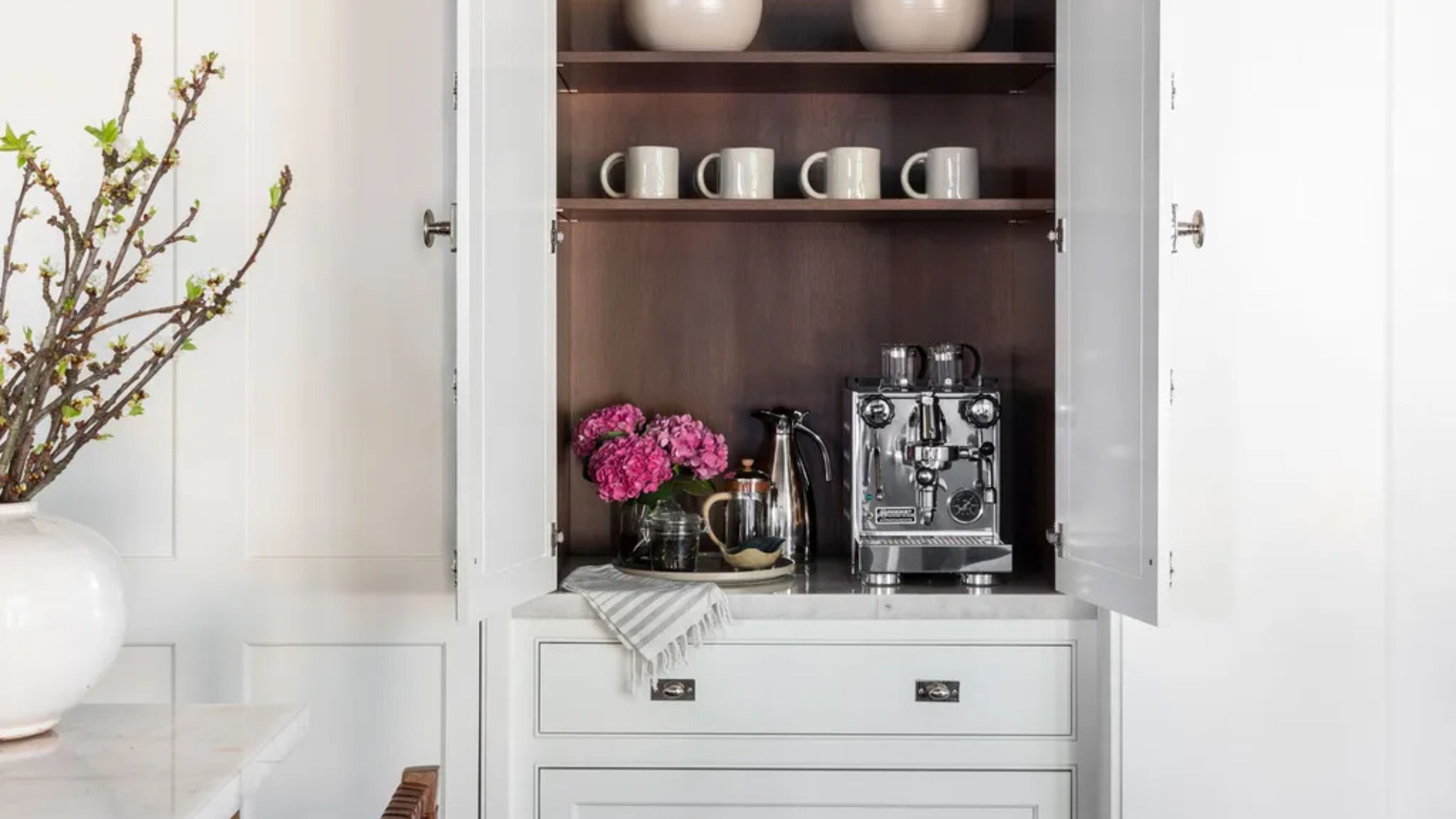 Turns Out the Coolest New Café is Actually In Your Kitchen — Here's How to Steal the Style of TikTok's Latest Trend
Turns Out the Coolest New Café is Actually In Your Kitchen — Here's How to Steal the Style of TikTok's Latest TrendGoodbye, over-priced lattes. Hello, home-brewed coffee with friends. TikTok's 'Home Cafe' trend brings stylish cafe culture into the comfort of your own home
By Devin Toolen Published
-
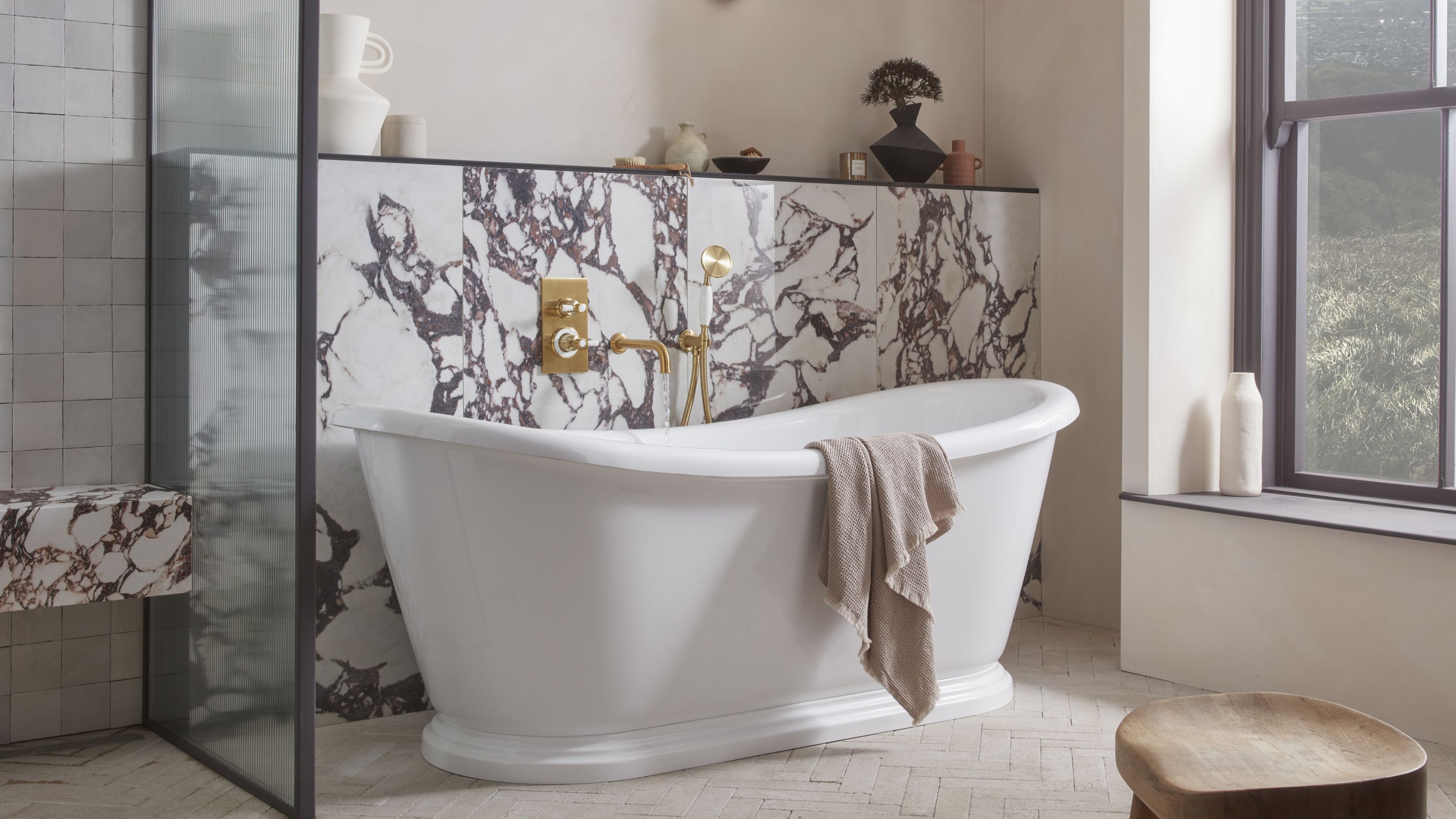 5 Bathroom Layouts That Look Dated in 2025 — Plus the Alternatives Designers Use Instead for a More Contemporary Space
5 Bathroom Layouts That Look Dated in 2025 — Plus the Alternatives Designers Use Instead for a More Contemporary SpaceFor a bathroom that feels in line with the times, avoid these layouts and be more intentional with the placement and positioning of your features and fixtures
By Lilith Hudson Published
-
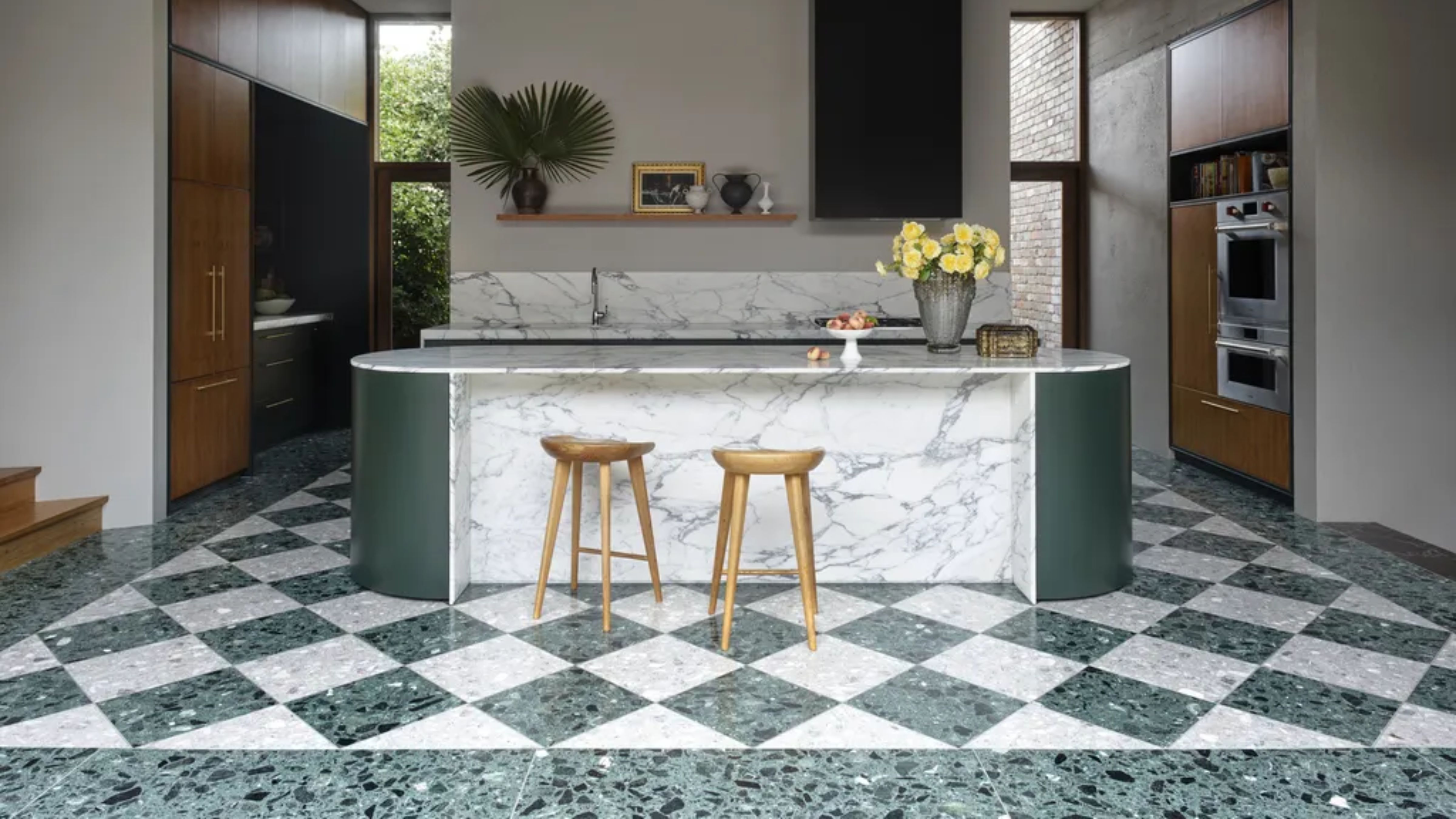 Smeg Says Teal, and We’re Listening — The Kitchen Shade of the Year Is Here
Smeg Says Teal, and We’re Listening — The Kitchen Shade of the Year Is HereDesigners are already using the soft, sea-glass green everywhere from cabinetry to countertops
By Julia Demer Published
-
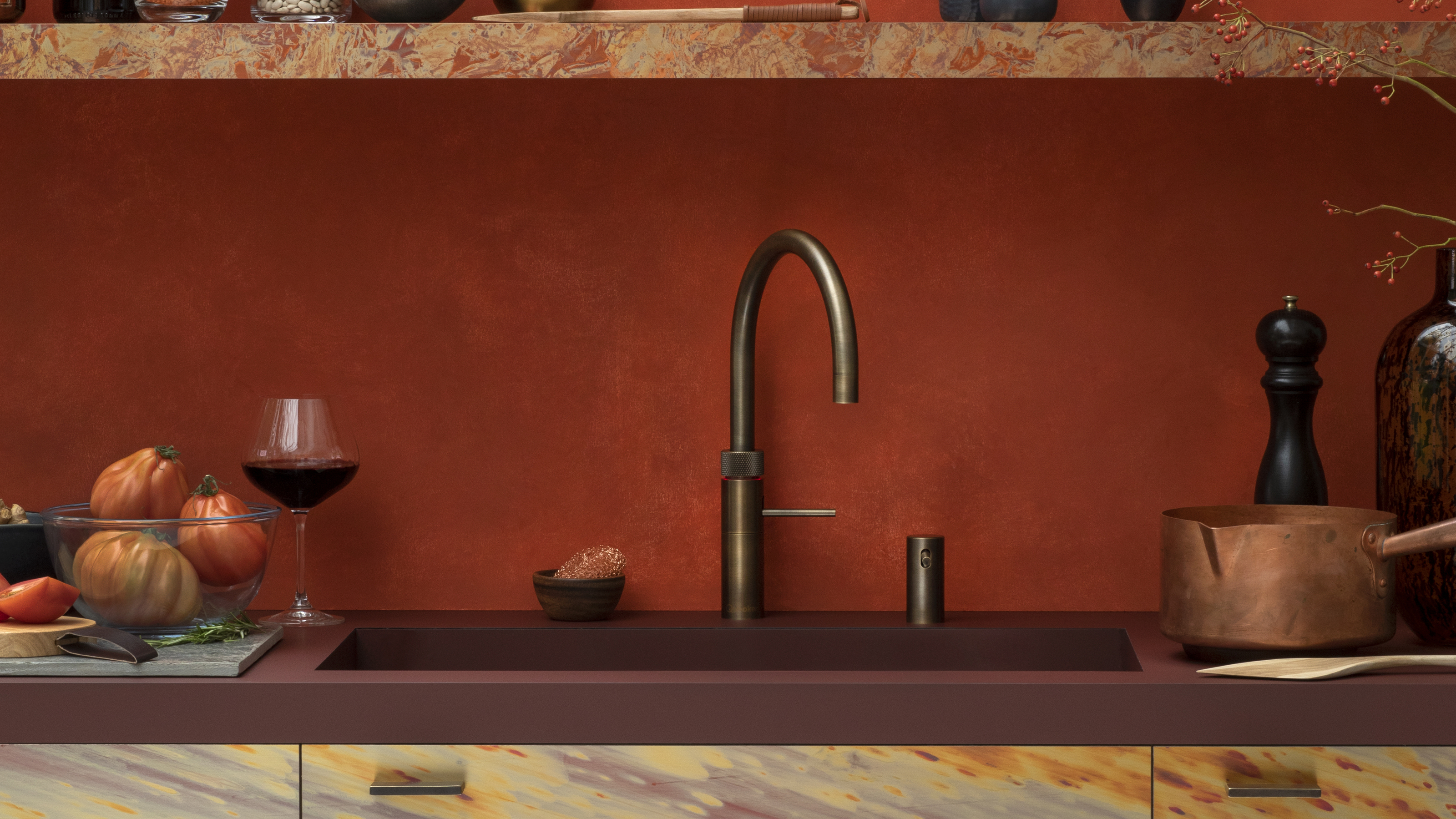 5 Problems With Boiling Water Taps That No One Ever Talks About — And How to Troubleshoot Them
5 Problems With Boiling Water Taps That No One Ever Talks About — And How to Troubleshoot ThemWe got our experts to spill the beans on the truth behind these kitchen staples
By Maya Glantz Published
-
 Does a Kitchen Need to Have a Door? The Pros and Cons (and Regulations) Explained
Does a Kitchen Need to Have a Door? The Pros and Cons (and Regulations) ExplainedAs popular as open-plan kitchens may be, they aren't for everyone. Our experts break down all the pros and cons of this design style.
By Maya Glantz Published
-
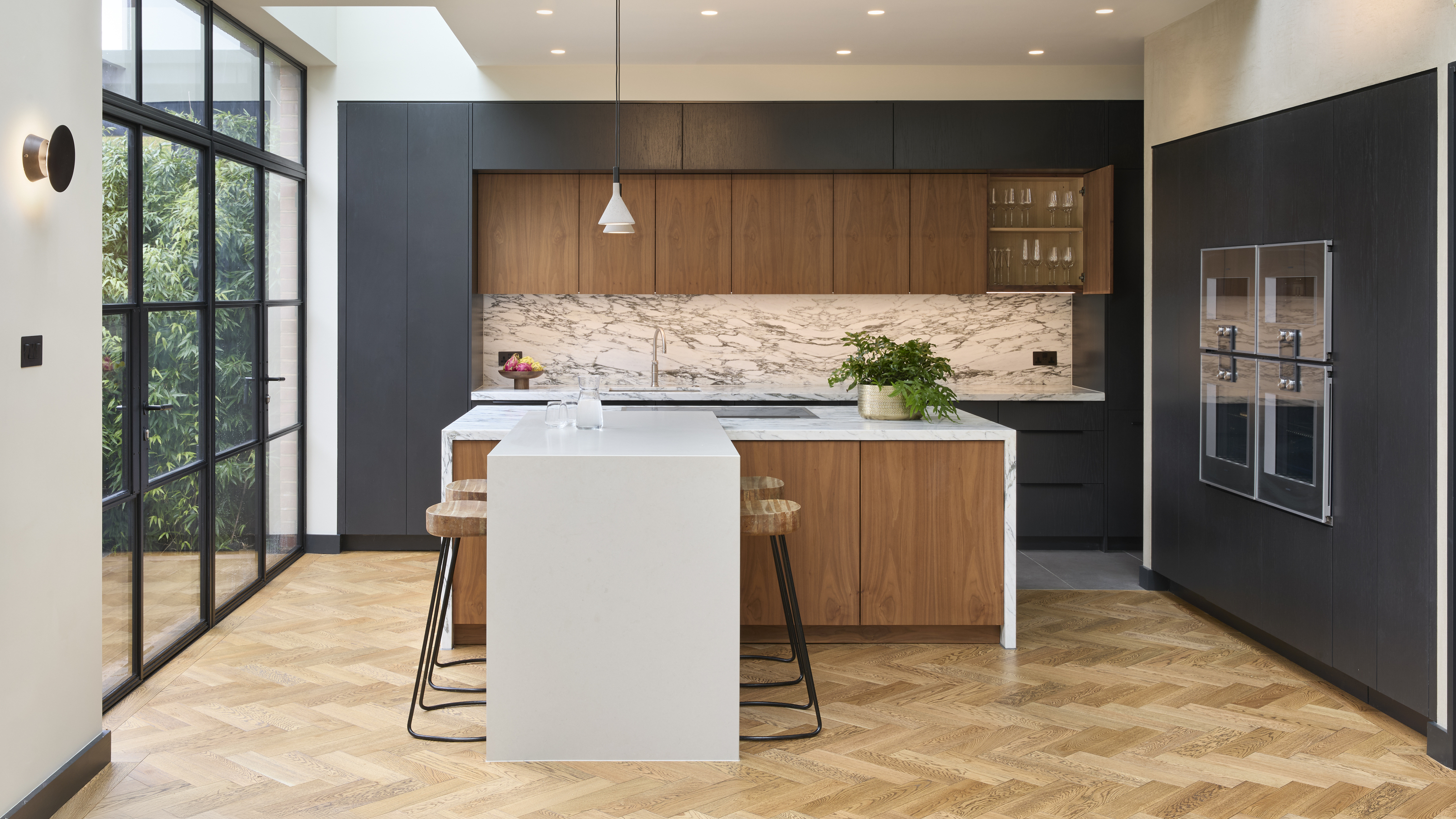 5 Kitchen Layouts That Are Dated in 2025 — Plus the Contemporary Blueprints Designers Are Choosing Instead
5 Kitchen Layouts That Are Dated in 2025 — Plus the Contemporary Blueprints Designers Are Choosing InsteadIf you want to design a kitchen with a coherent floorplan conducive to better flow and functionality, these are the layouts to steer clear of
By Lilith Hudson Published
-
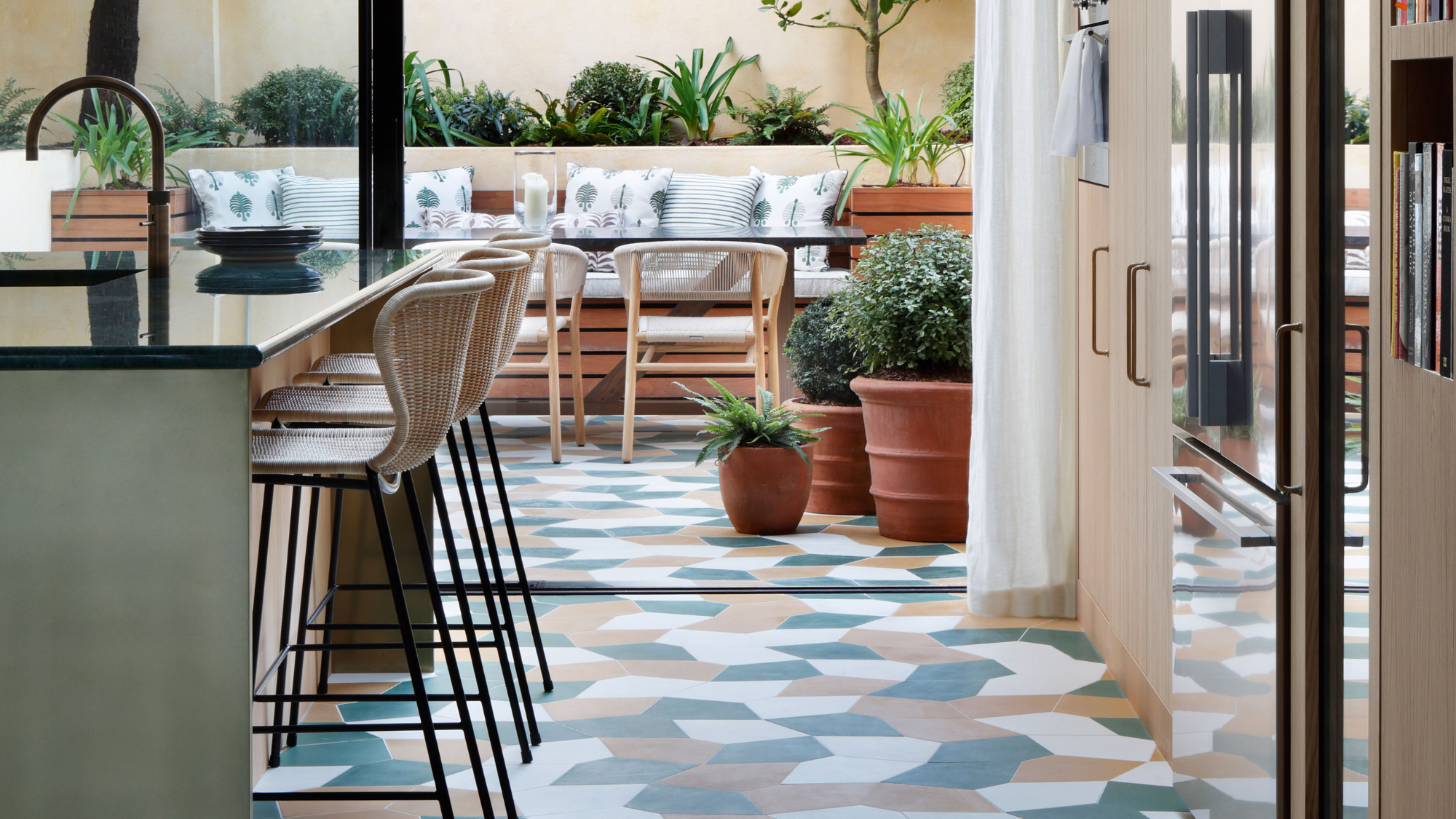 11 Kitchen Flooring Ideas to Build a Brilliant Renovation Scheme From the Ground Up
11 Kitchen Flooring Ideas to Build a Brilliant Renovation Scheme From the Ground UpStarting with your kitchen's flooring isn't a bad idea when it comes to creating a successful scheme — here are 11 modern ways to do it, and expert advice from interior designers
By Tessa Pearson Published
-
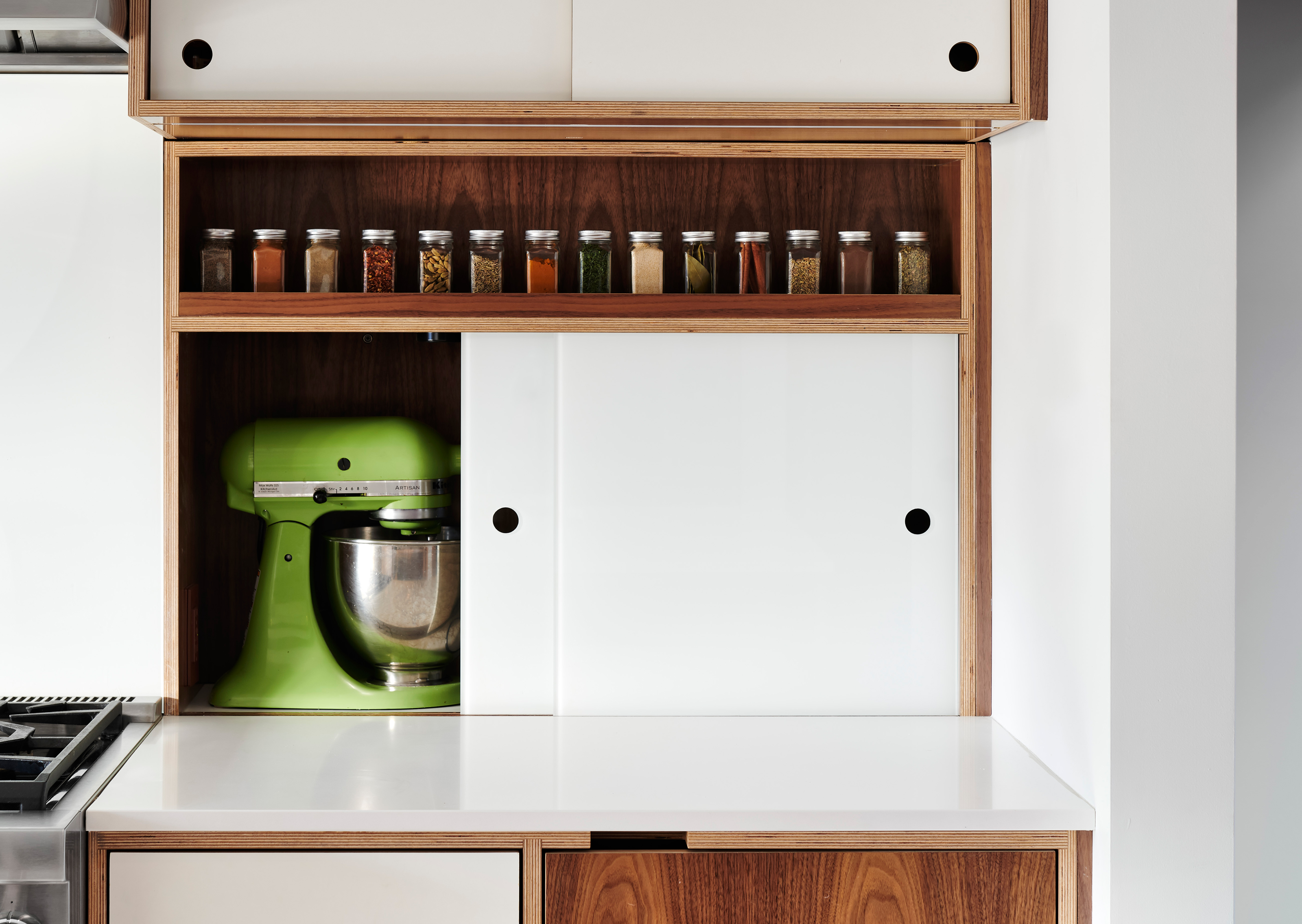 "I Just Bought a Stand Mixer — Where Can I Store It in My Small Kitchen?" 6 Clever Storage Ideas to Consider
"I Just Bought a Stand Mixer — Where Can I Store It in My Small Kitchen?" 6 Clever Storage Ideas to ConsiderLove your stand mixer, but hate not knowing how to store it? We've got the same problem, but these six expert tips have solved our limited storage problems for good.
By Amiya Baratan Published
-
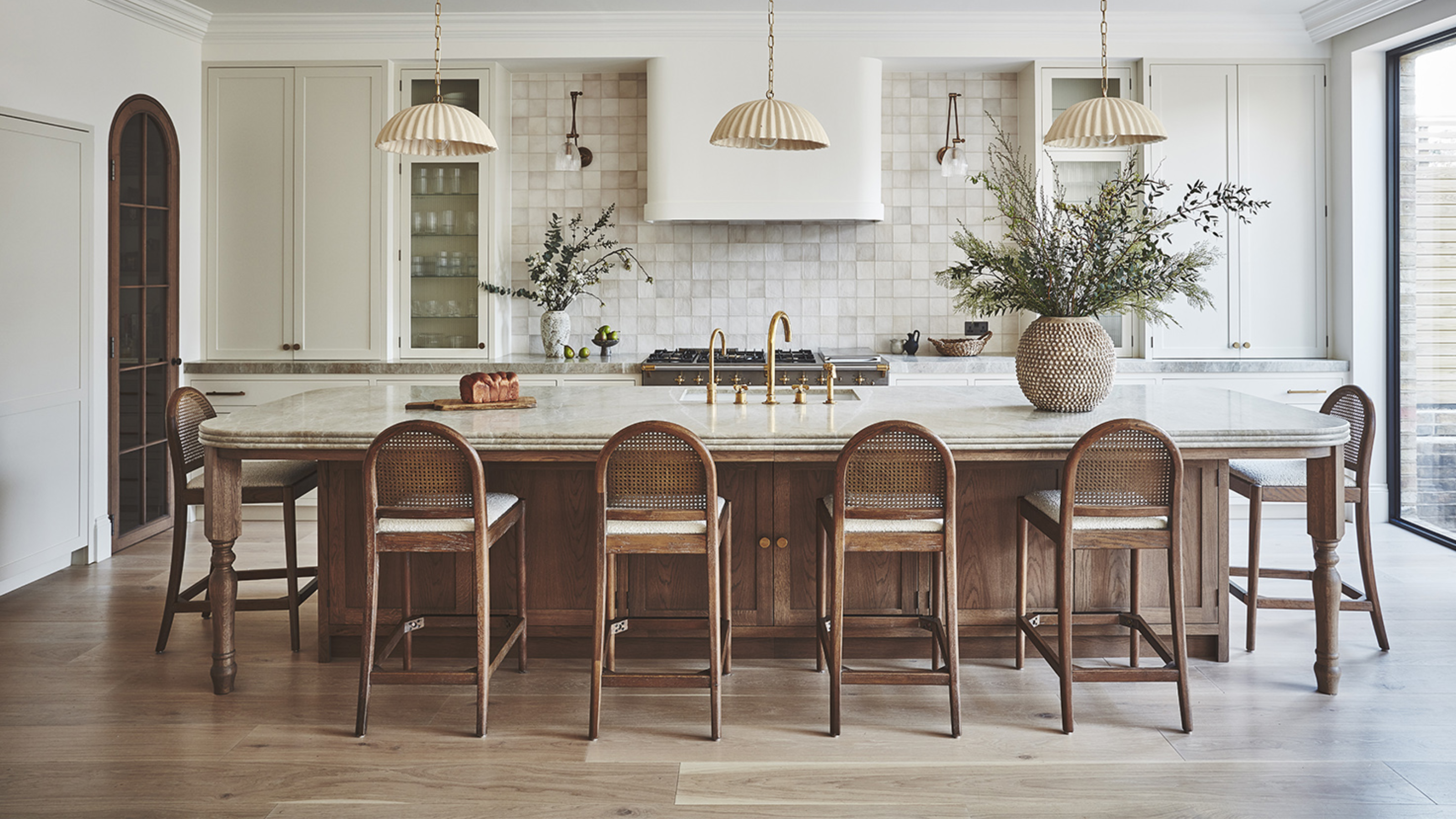 Bar Stools vs Counter Stools — The Difference You Need to Know to Avoid Buying the Wrong One for Your Kitchen
Bar Stools vs Counter Stools — The Difference You Need to Know to Avoid Buying the Wrong One for Your KitchenYou might think they're the same thing, but bar stools and counter stools are subtly different, and knowing how will help you avoid buying the wrong ones
By Maya Glantz Published
-
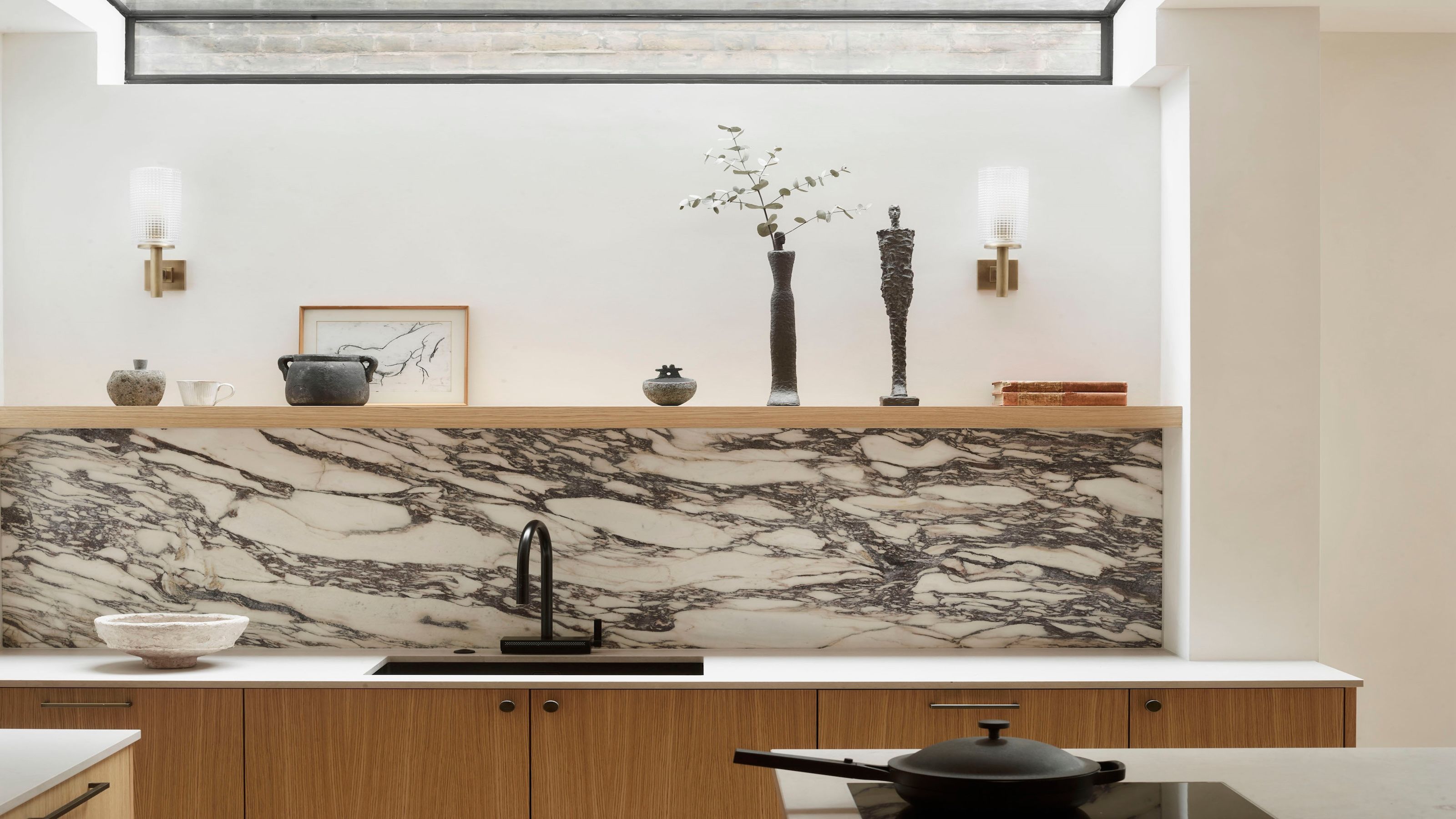 10 Kitchen Tap Ideas That Will Upgrade Your Sink — Who'd Have Thought Doing the Dishes Could Look This Good?
10 Kitchen Tap Ideas That Will Upgrade Your Sink — Who'd Have Thought Doing the Dishes Could Look This Good?From pot fillers to pull-out hoses, these are the kitchen taps that the experts are lusting over right now…
By Lara Sargent Published